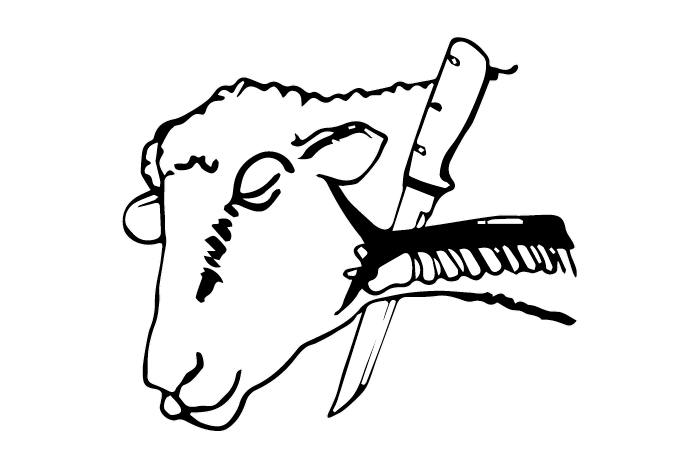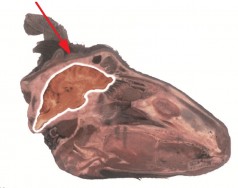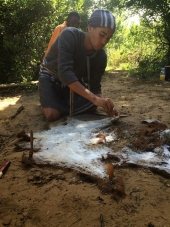




 2
2




 2
2











 1
1




 8
8




"Yeah, well, that's just, like, your opinion, man" - The Dude
"It is what it is til it aint" - Mac Miller
 2
2




Invasive plants are Earth's way of insisting we notice her medicines. Stephen Herrod Buhner
Everyone learns what works by learning what doesn't work. Stephen Herrod Buhner
 4
4




 4
4




 3
3




 3
3




Terrie Schweitzer wrote:I had the same sorts of questions before doing this with two small goats (about 6-7 months old) a few years ago.
I didn't have firearms and was hearing much what others have said here...that it's not a sure bet. I had seen a mobile butcher slit throats, but worried that I lacked the skill.
I was pleased with the results of this process:
- Dug a hole for blood and the offal I wasn't going to use
- Got a Stanley Fat Max Extreme snap-off knife with new heavy duty blade
- Had a second person help hold the legs of the goat; lay it down with it's neck over the hole and keep it pinned down.
- I'm holding the goat's head with my non-dominant hand and arms, laying down next to it.
- Take a deep breath and pull strongly yet quickly across. No time to be hesitant.
The problem with this method is that the goat was in more distress than I would like, but it wasn't terrible. And other than that discomfort, I felt that it was a very clean kill. (They will make a running motion afterwards for a minute or so; this also happened when the butcher slit throats on standing goats.) It seemed to me it would be worse to try somehow to have them on their feet and mess up. I think you have to sort out what is going to work for you and your own animals to some extent.
Good luck!
 2
2





 4
4




 1
1




Henry Brown wrote:Thanks for the post on the bolt, I followed the link and it has citations to Temple Grandin, which is reassuring.
In my community we always did ritual offerings with knife, and now I have to do it on my own. I am sad to say I didn't do such a great job with my first animal, but at least I was decisive and it could have been worse. It was a quail. I just feel a need to shake a little trauma out of my system here. I appreciate getting to "process." If I ever do larger animals someday I hope I will be able to do better.




JohnP Burke wrote:I started a small herd of goats for meat. In my reading and researching it seems like every one butchers by cutting the jugular or stabbing the heart. The videos I have seen seem quite cruel. Is there a reason people do it like this? Will a head shot with a hand gun have some kind of draw back? It seems more humane with just a quick shot but no one seems to do it that way.

The throat cut aims to sever the carotid arteries at the level of the throat, near where the neck joins the head. It may make pathological changes in this area difficult to assess at necropsy. The best method for performing the throat cut is by fully inserting the knife just behind the angle of the jaw beneath the neck bones (Figure 9.4). A knife such as a boning knife with strong, sharp 15 cm blade, a pointed tip and a non-slip handle is essential. This method causes the carotid arteries to be cut during insertion of the knife. An outward cut (directed ventrally) ensures the carotid arteries and jugular veins are severed and also the windpipe.
List 1: Captive Bolt or Gunshot - Methods that physically damage the brain. Signs of properly stunned insensible (unconscious) animals - primary indicators.
No eye movements and eyes open to a wide blank stare. The corneal reflex (touch the eye) natural spontaineous blinking and nystagmus (vibrating eyelid) must all be ABSENT. Verify unconsciousness by touching the eye.
No rhythmic breathing (ribcage moves in and out)
No righting reflex; no attempt to lift head or stand up
No vocalization - squeal, bellow, moo.
All four primary indicators MUST BE ABSENT in a properly stunned animal.


 2
2




Amy Arnett wrote:
From what I have read, the key to a quick and almost painless kill by bleeding out (exsanguination) is cutting both carotid arteries, so cutting all the way through the neck. This works for goats because it cuts off all blood supply to the brain in one stroke so they go into shock pretty quick. This wouldn't work for cattle as they have a redundant blood supply in the spinal cord. Not sure about other animals.
From http://www.veterinaryhandbook.com.au/ContentSection.aspx?id=40
The throat cut aims to sever the carotid arteries at the level of the throat, near where the neck joins the head. It may make pathological changes in this area difficult to assess at necropsy. The best method for performing the throat cut is by fully inserting the knife just behind the angle of the jaw beneath the neck bones (Figure 9.4). A knife such as a boning knife with strong, sharp 15 cm blade, a pointed tip and a non-slip handle is essential. This method causes the carotid arteries to be cut during insertion of the knife. An outward cut (directed ventrally) ensures the carotid arteries and jugular veins are severed and also the windpipe.




 1
1




JohnP Burke wrote:Thank you every one there is a lot of good information here.
Now I have more questions lol.
I really like the captive bolt gun because with a hand gun there is always a risk of the bullet hitting a rock and ricocheting into my foot. The question I have now is why do they say "stun" I would think a 1/4 bolt piercing the brain would kill
'Theoretically this level of creeping Orwellian dynamics should ramp up our awareness, but what happens instead is that each alert becomes less and less effective because we're incredibly stupid.' - Jerry Holkins




JohnP Burke wrote:The question I have now is why do they say "stun" I would think a 1/4 bolt piercing the brain would kill
Physiological Effects of Percussive Stunning
When a sharp, heavy blow is correctly applied to the skull it produces a rapid acceleration of
the head, causing the brain to impact against the inside of the skull. There is disruption of
normal electrical activity resulting from sudden, massive increase in intra-cranial pressure,
followed by an equally sudden drop in pressure. The consequent damage to the nerves and
blood vessels causes brain dysfunction and/or destruction, and impaired blood circulation.
The duration of insensibility depends on the severity of damage to the nervous tissue and
the degree to which the blood supply is reduced. In addition, there may be physical damage
to the skull or brain according to the type of stunner used, i.e. penetrative or nonpenetrative.


 1
1




"Where will you drive your own picket stake? Where will you choose to make your stand? Give me a threshold, a specific point at which you will finally stop running, at which you will finally fight back." (Derrick Jensen)

|
Let me tell ya a story about a man named Jed. Poor mountain man with a tiny ad:
Rocket Mass Heater Resources Wiki
https://permies.com/w/rmh-resources
|





